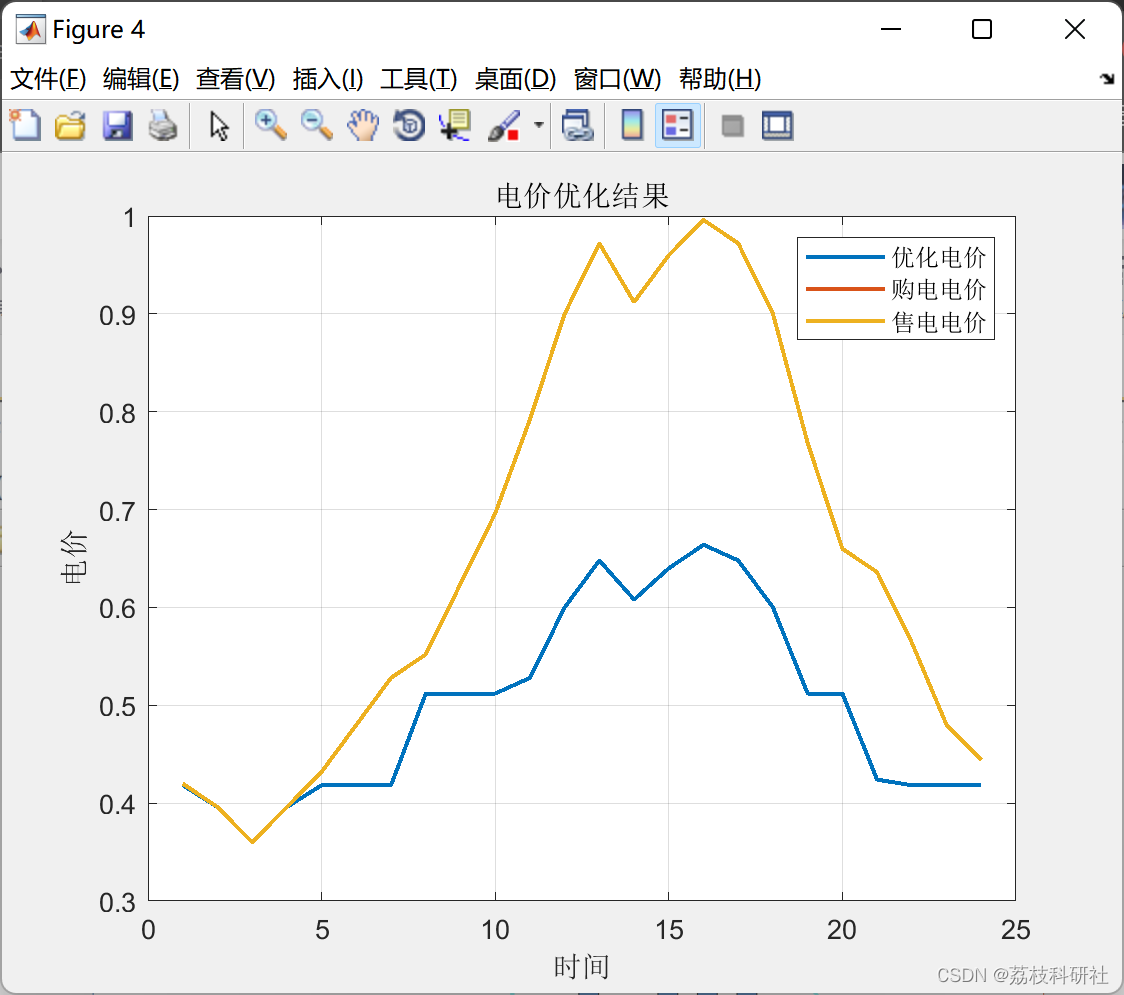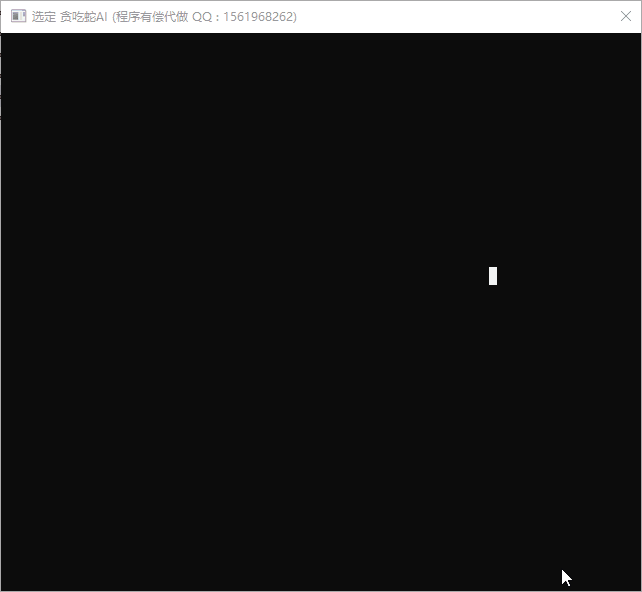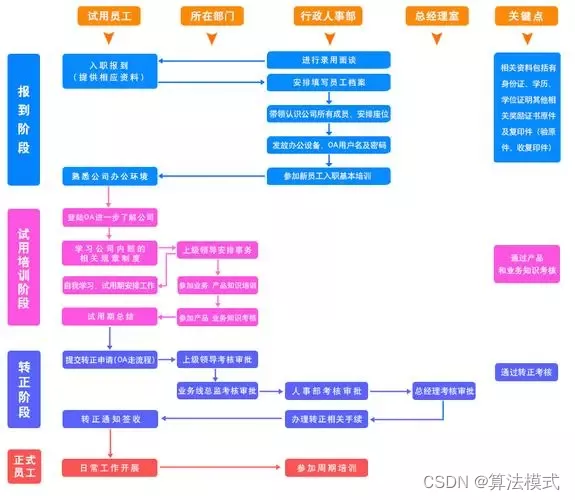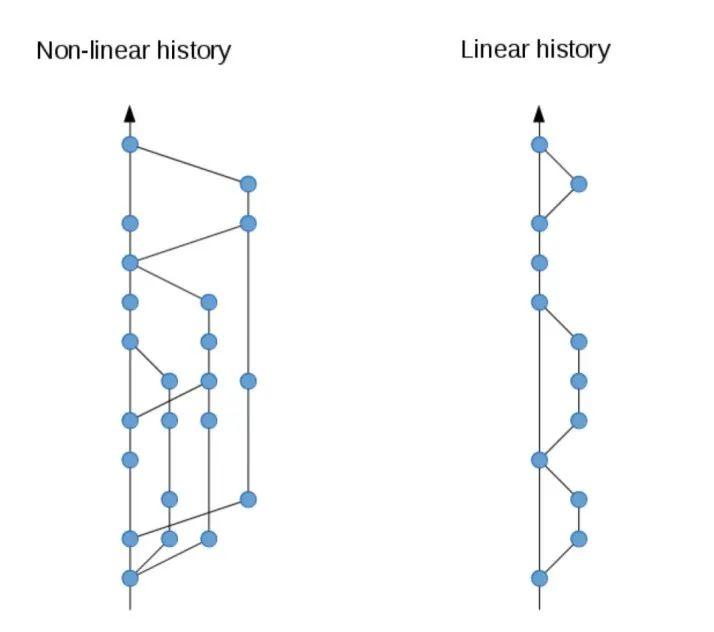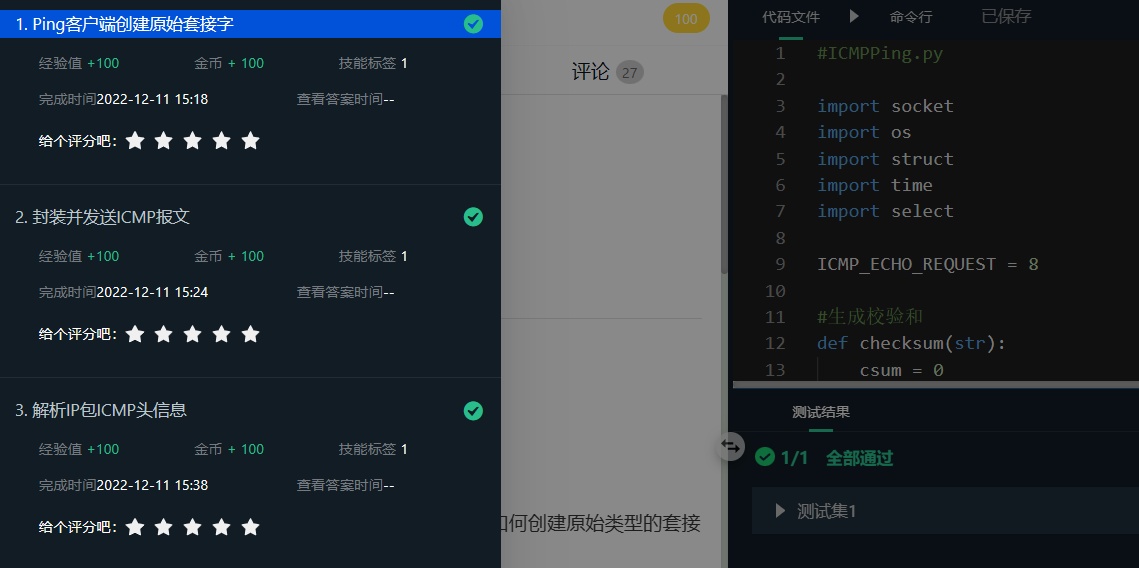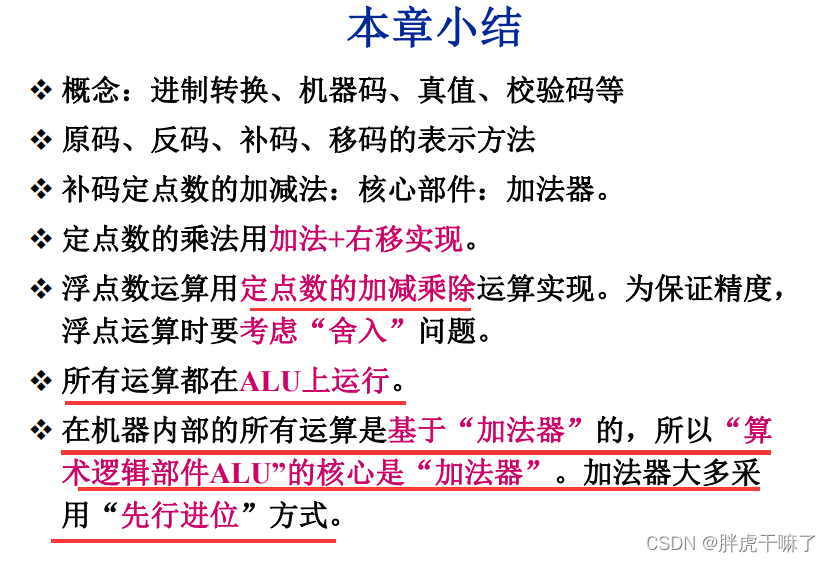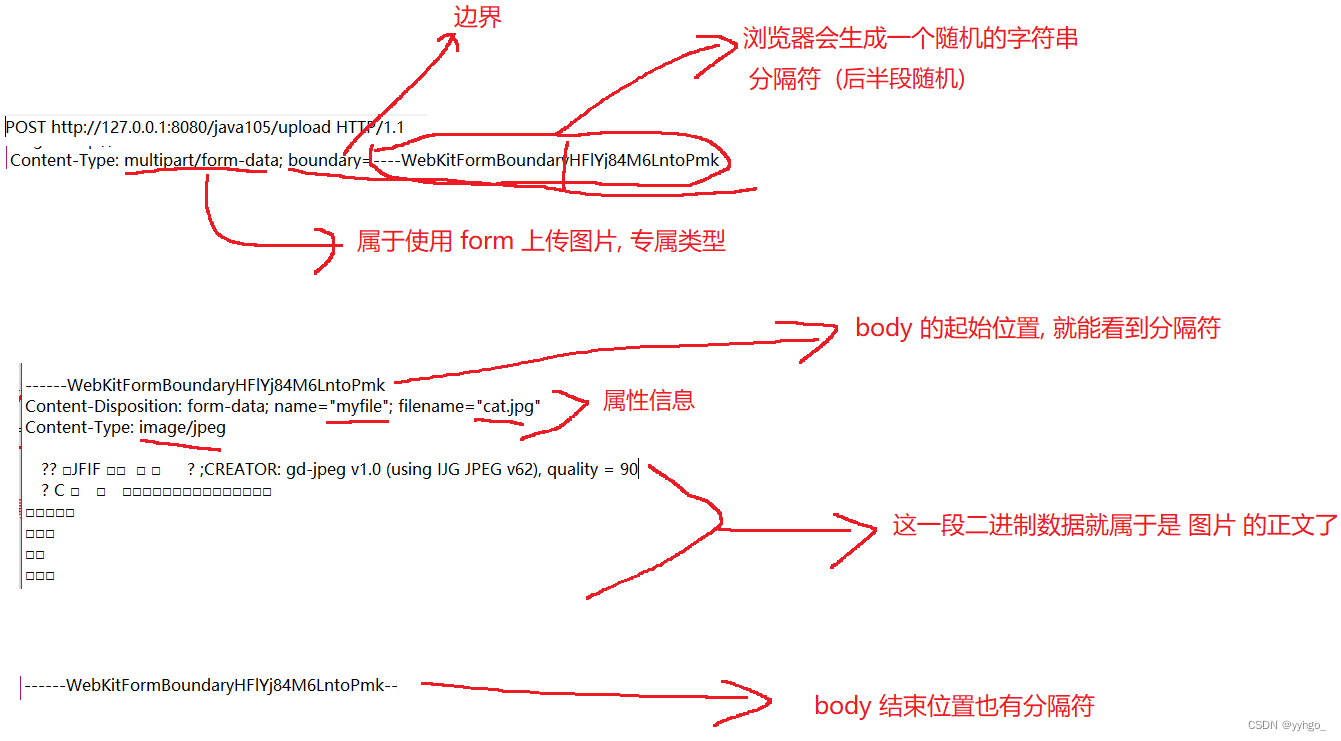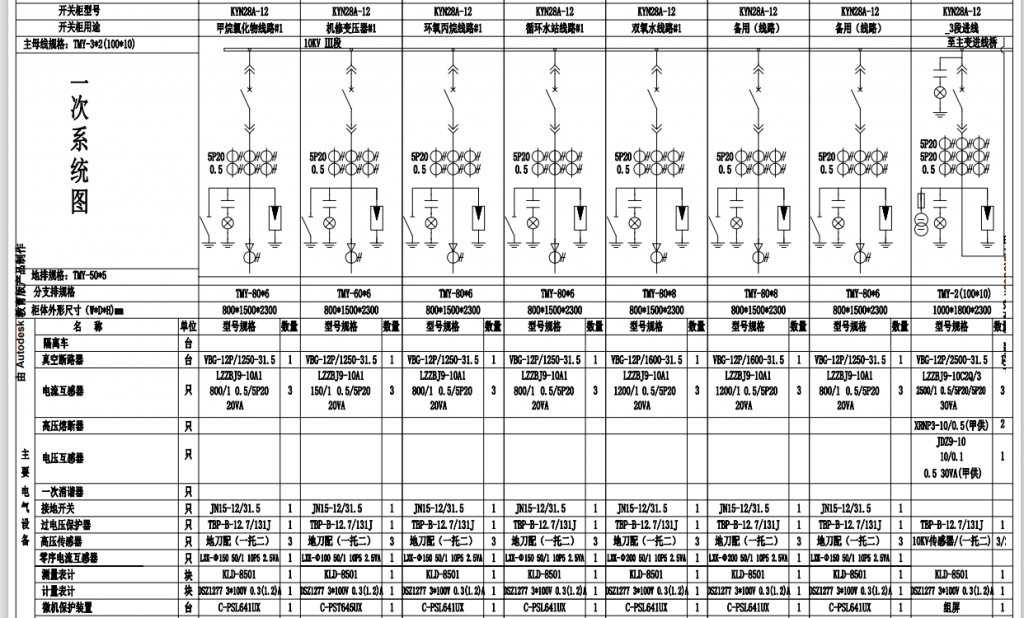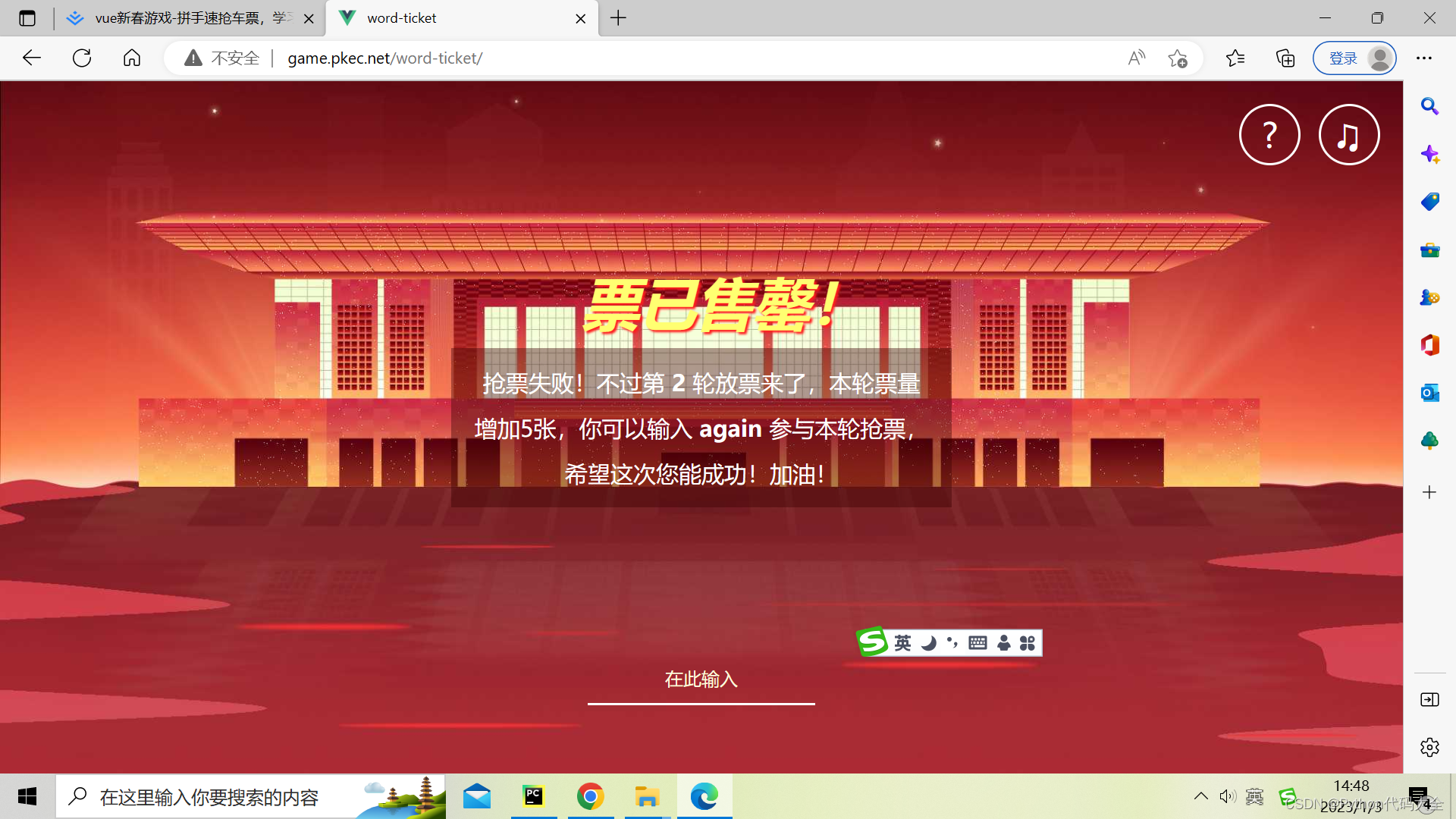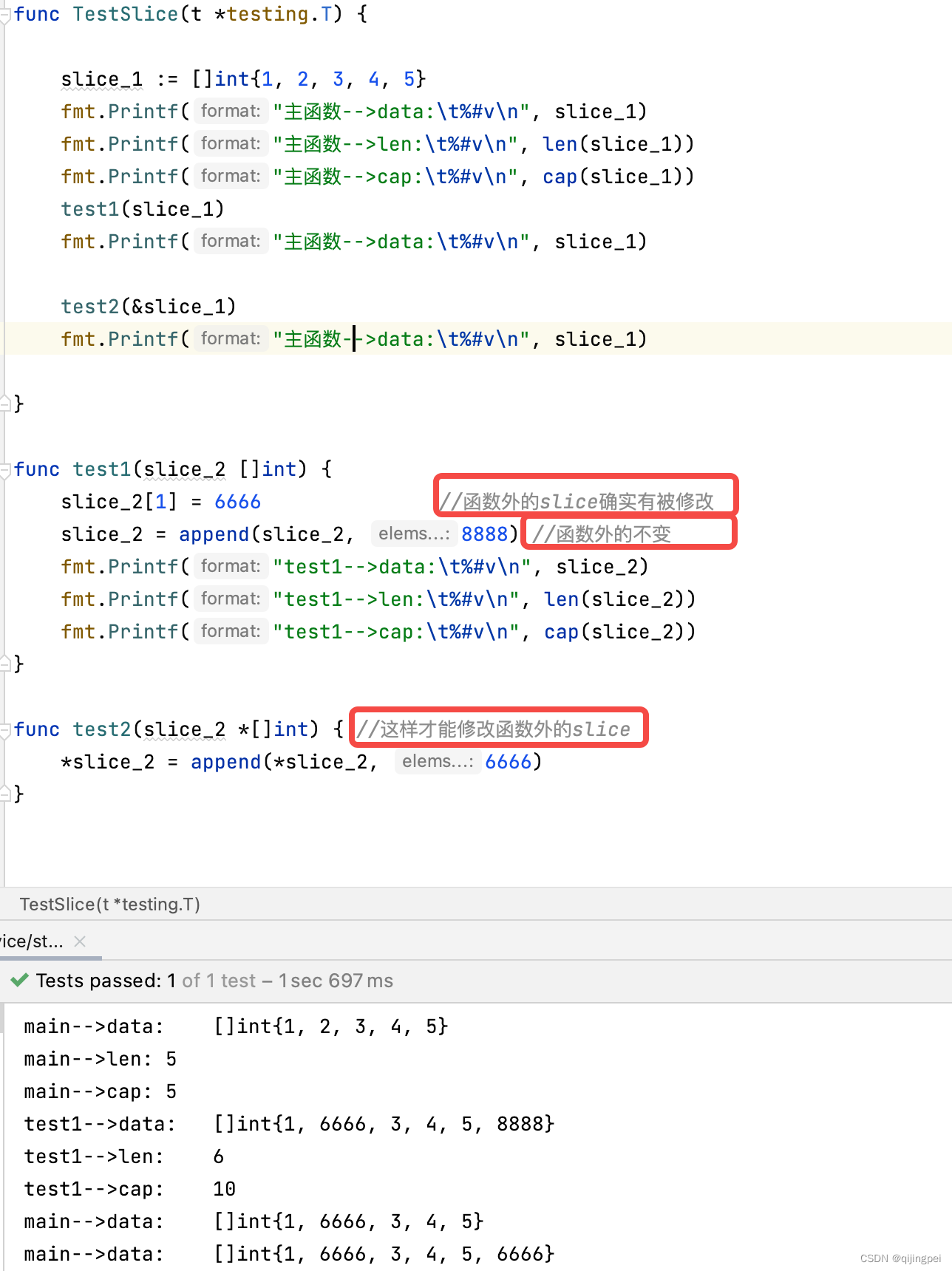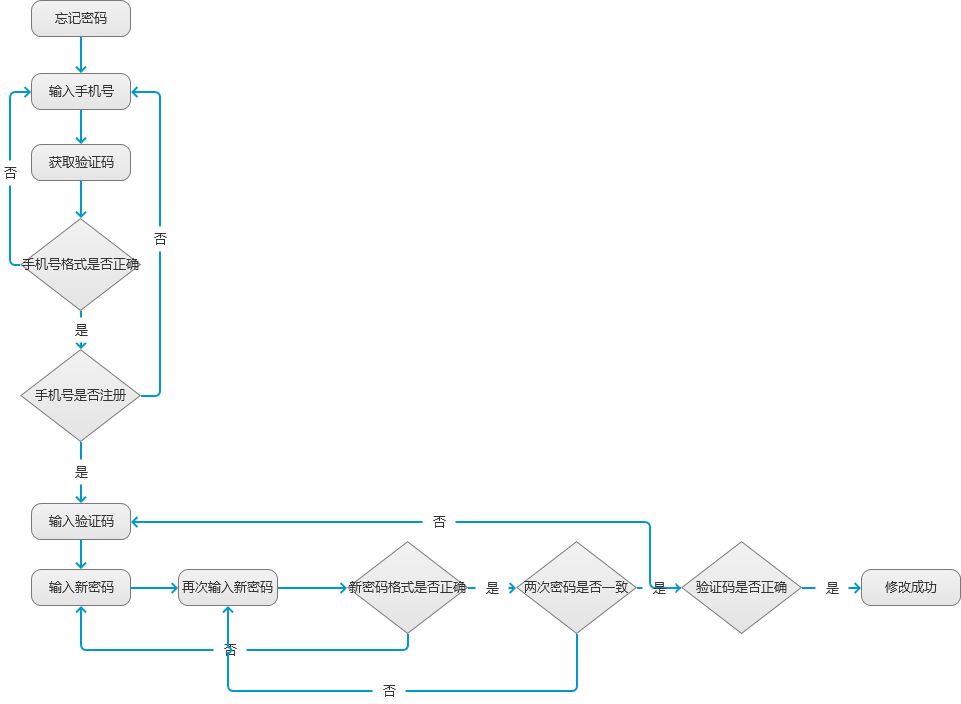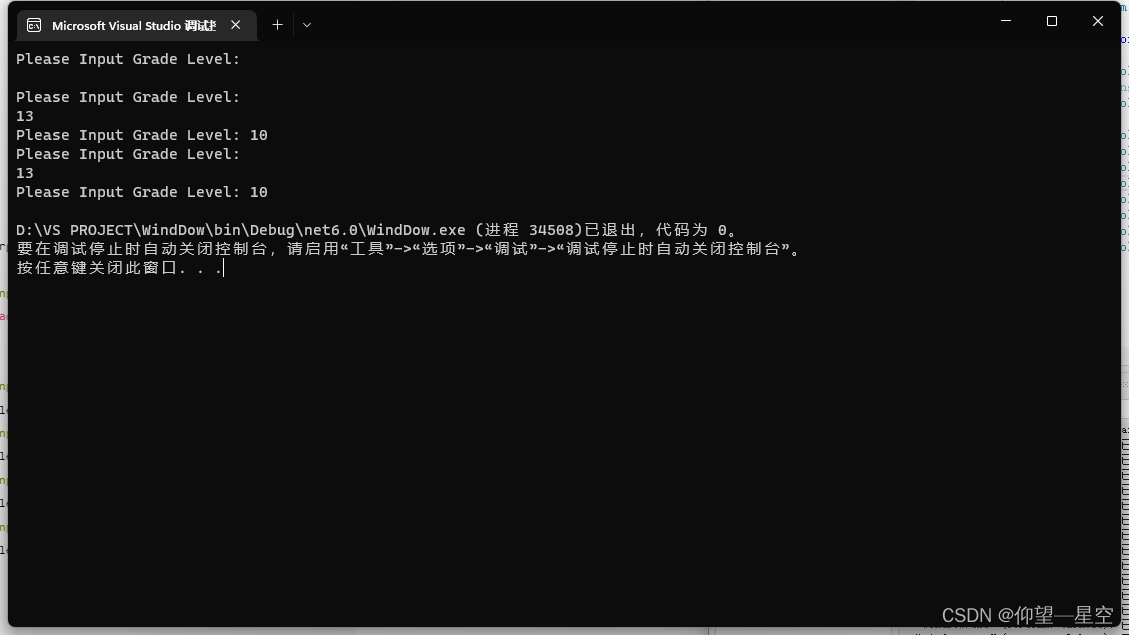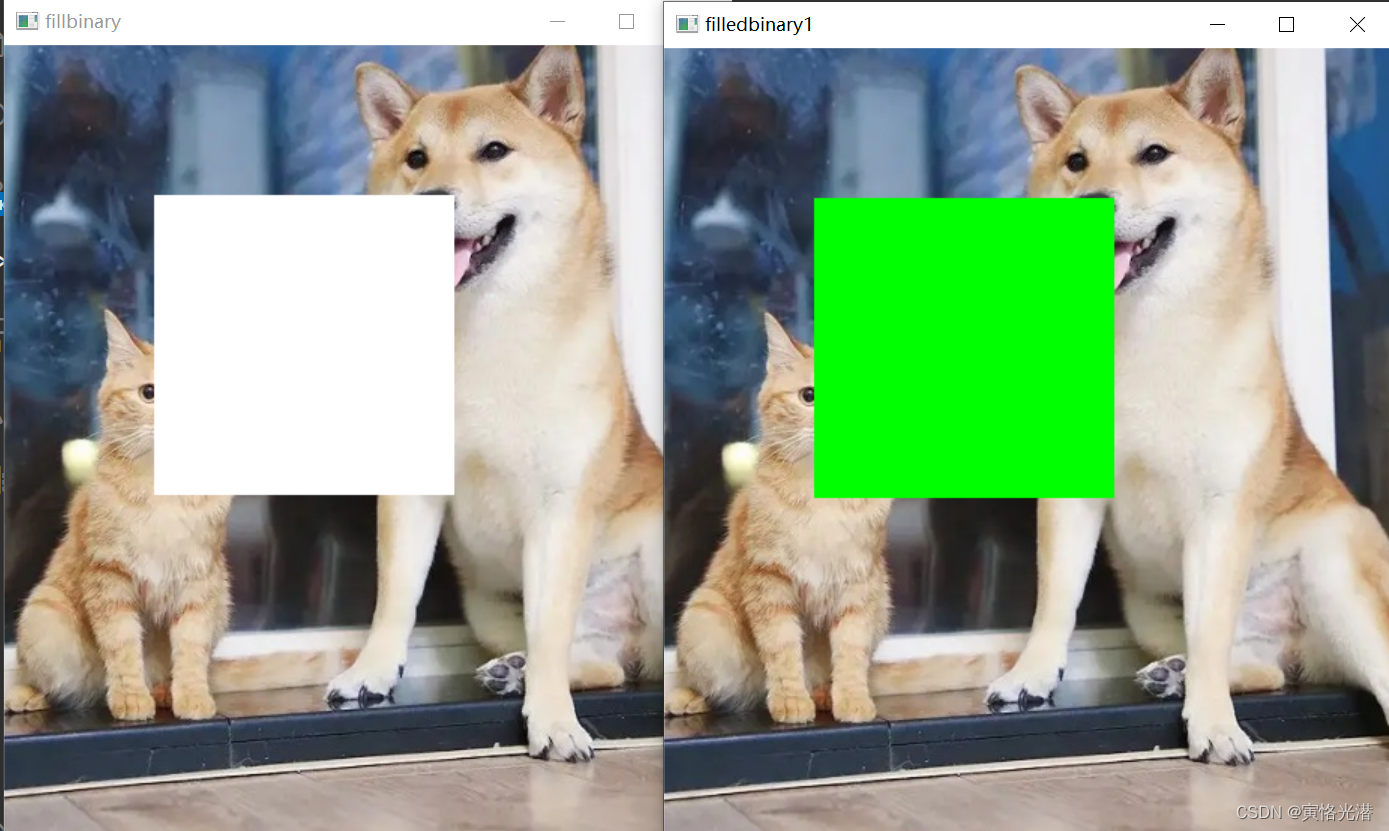目录
一:异步通信技术AJAX | 快速搞定AJAX(第四篇)
1、AJAX实现省市联动
2、超链接、form表单和JS代码跨域
3、AJAX跨域问题
(1)测试Ajax跨域访问
(2)同源 & 不同源
(3)AJAX跨域解决方案1:设置响应头
(4)AJAX跨域解决方案2:jsonp
(5)AJAX跨域解决方案3:jQuery封装的jsonp
(6)AJAX跨域解决方案4:代理机制(httpclient)
(7)AJAX跨域解决方案5:nginx反向代理
一:异步通信技术AJAX | 快速搞定AJAX(第四篇)
1、AJAX实现省市联动
(1)什么是省市联动? -
在网页上,选择对应的省份之后,动态的关联出该省份对应的市。选择对应的市之后,动态的关联出该市对应的区。(首先要清楚需求)
(2)进行数据库表的设计:t_area (区域表)
将全国所有的省、市、区、县等信息都存储到一张表当中。
采用的存储方式实际上是code(编号) 和 pcode(父编号)形势。
id(PK-自增) code(编号) name(名字) pcode(父编号)
(3)建表t_area,模拟好数据;这里只做省市!

(4)页面加载完毕之后,先把省份全部展现出来
注:这里还是要先创建一个Area类,把从数据库中取出来的数据放里面,然后在放入一个List集合,最终 响应给浏览器,进行处理
Area类
package com.bjpowernode.javaweb.bean;
/**
* @program: 代码
* @ClassName: Area
* @version: 1.0
* @description: 区域
* @author: bjpowernode
* @create: 2022-05-15 22:02
**/
public class Area {
private String code;
private String name;
public Area() {
}
public Area(String code, String name) {
this.code = code;
this.name = name;
}
public String getCode() {
return code;
}
public void setCode(String code) {
this.code = code;
}
public String getName() {
return name;
}
public void setName(String name) {
this.name = name;
}
}
前端代码
<!DOCTYPE html>
<html lang="en">
<head>
<meta charset="UTF-8">
<title>省市联动</title>
</head>
<body>
<!--引入我们自己编写的jQuery库-->
<script type="text/javascript" src="/ajax/js/jQuery-1.0.0.js"></script>
<script type="text/javascript">
$(function () { // 页面加载
$.ajax({ //传一个JSON格式的数据过去
type : "get",
url : "/ajax/listArea",
data : "t=" + new Date().getTime(),
async : true,
success : function (jsonArr) {
// 拿到数据进行拼串,然后放到下拉列表select下面
var html = "<option value=''>--请选择省份--</option>";
// 拿到的JSON数据肯定是一个数组
for (var i = 0; i <jsonArr.length; i++) {
var area = jsonArr[i];
html += "<option value='"+area.code+"'>"+area.name+"</option>"
}
// 拼好串以后,把数据放到下拉列表中输出
$("#province").html(html)
}
})
})
</script>
<select id="province">
<!--显示省份-->
</select>
</body>
</html>后端代码
package com.bjpowernode.javaweb.ajax;
import com.alibaba.fastjson.JSON;
import com.bjpowernode.javaweb.bean.Area;
import javax.servlet.ServletException;
import javax.servlet.annotation.WebServlet;
import javax.servlet.http.HttpServlet;
import javax.servlet.http.HttpServletRequest;
import javax.servlet.http.HttpServletResponse;
import java.io.IOException;
import java.sql.*;
import java.util.*;
/**
* @program: 代码
* @ClassName: ListAreaServlet
* @version: 1.0
* @description: 动态获取对应的区域
* @create: 2022-05-15 21:57
**/
@WebServlet("/listArea")
public class ListAreaServlet extends HttpServlet {
@Override
protected void doGet(HttpServletRequest request, HttpServletResponse response)
throws ServletException, IOException {
// 连接数据库,获取所有的对应区域。最终响应一个JSON格式的字符串给WEB前端。
Connection conn = null;
PreparedStatement ps = null;
ResultSet rs = null;
List<Area> areaList = new ArrayList<>();
try {
// 注册驱动
Class.forName("com.mysql.jdbc.Driver");
// 获取连接
String url = "jdbc:mysql://localhost:3306/bjpowernode?useUnicode=true&characterEncoding=UTF-8";
String user = "root";
String password = "***";
conn = DriverManager.getConnection(url, user, password);
System.out.println(conn);
// 获取预编译数据库操作对象
String sql = "select code,name from t_area where pcode is null";
ps = conn.prepareStatement(sql);
// 执行SQL
rs = ps.executeQuery();
// 处理结果集
while (rs.next()) {
// 取出数据
String code = rs.getString("code");
String name = rs.getString("name");
// 封装一个类,把数据放入里面
Area a = new Area(code, name);
// 把这个类再放到集合里面
areaList.add(a);
}
} catch (Exception e) {
e.printStackTrace();
} finally {
// 释放资源
if (rs != null) {
try {
rs.close();
} catch (SQLException e) {
e.printStackTrace();
}
}
if (ps != null) {
try {
ps.close();
} catch (SQLException e) {
e.printStackTrace();
}
}
if (conn != null) {
try {
conn.close();
} catch (SQLException e) {
e.printStackTrace();
}
}
}
response.setContentType("text/html;charset=UTF-8");
// 使用fastjson将java对象转换成json字符串。
String json = JSON.toJSONString(areaList);
// 响应JSON。
response.getWriter().print(json);
}
}
效果展示:只要类一加载就会从数据中获取省份

(5)然后选择省份,只要change事件一发生,就发送Ajax请求,显示出对应的市
前端代码
change时间发生,发送Ajax请求,然后根据pcode获取对应的市;在定义一个下拉列表,进行数据的显示
<!DOCTYPE html>
<html lang="en">
<head>
<meta charset="UTF-8">
<title>省市联动</title>
</head>
<body>
<!--引入我们自己编写的jQuery库-->
<script type="text/javascript" src="/ajax/js/jQuery-1.0.0.js"></script>
<script type="text/javascript">
$(function () { // 页面加载
$.ajax({ //传一个JSON格式的数据过去
type : "get",
url : "/ajax/listArea",
data : "t=" + new Date().getTime(),
async : true,
success : function (jsonArr) {
// 拿到数据进行拼串,然后放到下拉列表select下面
var html = "<option value=''>--请选择省份--</option>";
// 拿到的JSON数据肯定是一个数组
for (var i = 0; i <jsonArr.length; i++) {
var area = jsonArr[i];
html += "<option value='"+area.code+"'>"+area.name+"</option>"
}
// 拼好串以后,把数据放到下拉列表中输出
// 这是省的下拉列表
$("#province").html(html)
}
})
// 只要province元素的change事件发生,就发送请求
$("#province").change(function(){
// 发送ajax请求
$.ajax({
type : "get",
url : "/ajax/listArea",
// 这里要把pcode传过去,this.value就是获取到的pcode
data : "t=" + new Date().getTime() + "&pcode=" + this.value,
async : true,
success : function(jsonArr){
var html = "<option value=''>--请选择市--</option>";
for (var i = 0; i < jsonArr.length; i++) {
var area = jsonArr[i]
html += "<option value='"+area.code+"'>"+area.name+"</option>"
}
// 这是市的下拉列表
$("#city").html(html)
}
})
})
})
</script>
<select id="province">
<!--显示省份-->
</select>
<select id="city">
<!--显示省份,上面change事件发生,这里就会显示数据-->
</select>
</body>
</html>后端代码
两个Ajax请求可以共享一个Servlet;主要就是先获取pcode,看pcode是不是null:
如果是null表示发送的是页面加载显示省的请求;
如果不是null表示发送的是change时间显示市的请求
package com.bjpowernode.javaweb.ajax;
import com.alibaba.fastjson.JSON;
import com.bjpowernode.javaweb.bean.Area;
import javax.servlet.ServletException;
import javax.servlet.annotation.WebServlet;
import javax.servlet.http.HttpServlet;
import javax.servlet.http.HttpServletRequest;
import javax.servlet.http.HttpServletResponse;
import java.io.IOException;
import java.sql.*;
import java.util.*;
/**
* @program: 代码
* @ClassName: ListAreaServlet
* @version: 1.0
* @description: 动态获取对应的区域
* @create: 2022-05-15 21:57
**/
@WebServlet("/listArea")
public class ListAreaServlet extends HttpServlet {
@Override
protected void doGet(HttpServletRequest request, HttpServletResponse response)
throws ServletException, IOException {
// 获取到前端发送的pcode
String pcode = request.getParameter("pcode");
// 连接数据库,获取所有的对应区域。最终响应一个JSON格式的字符串给WEB前端。
Connection conn = null;
PreparedStatement ps = null;
ResultSet rs = null;
List<Area> areaList = new ArrayList<>();
try {
// 注册驱动
Class.forName("com.mysql.jdbc.Driver");
// 获取连接
String url = "jdbc:mysql://localhost:3306/bjpowernode?useUnicode=true&characterEncoding=UTF-8";
String user = "root";
String password = "***";
conn = DriverManager.getConnection(url, user, password);
// 获取预编译数据库操作对象
String sql = "";
if (pcode == null){// 如果pcode为null表示是省
sql = "select code,name from t_area where pcode is null";
ps = conn.prepareStatement(sql);
}else {// 如果pcode不为null表示是市
sql = "select code,name from t_area where pcode = ?";
ps = conn.prepareStatement(sql);
ps.setString(1,pcode);
}
// 执行SQL
rs = ps.executeQuery();
// 处理结果集
while (rs.next()) {
// 取出数据
String code = rs.getString("code");
String name = rs.getString("name");
// 封装一个类,把数据放入里面
Area a = new Area(code, name);
// 把这个类再放到集合里面
areaList.add(a);
}
} catch (Exception e) {
e.printStackTrace();
} finally {
// 释放资源
if (rs != null) {
try {
rs.close();
} catch (SQLException e) {
e.printStackTrace();
}
}
if (ps != null) {
try {
ps.close();
} catch (SQLException e) {
e.printStackTrace();
}
}
if (conn != null) {
try {
conn.close();
} catch (SQLException e) {
e.printStackTrace();
}
}
}
response.setContentType("text/html;charset=UTF-8");
// 使用fastjson将java对象转换成json字符串。
String json = JSON.toJSONString(areaList);
// 响应JSON。
response.getWriter().print(json);
}
}
执行效果:
①选择省:发送页面加载的Ajax请求

②省选择以后,发生了change事件,机会发送显示对应市的Ajax请求

2、超链接、form表单和JS代码跨域
(1)跨域是指从一个域名的网页去请求另一个域名的资源。比如从百度(https://baidu.com)页面去请求京东(https://www.jd.com)的资源。
(2)通过超链接、form表单提交或者JS代码的window.location.href的方式进行跨域是不存在问题的!但在一个域名的网页中的一段js代码发送ajax请求去访问另一个域名中的资源,由于同源策略的存在导致无法跨域访问,那么ajax就存在这种跨域问题。
(3)同源策略是指一段脚本只能读取来自同一来源的窗口和文档的属性,同源就是协议、域名和端口都相同。
(4)同源策略有什么用?如果你刚刚在网银输入账号密码,查看了自己还有1万块钱,紧接着访问一些不规矩的网站,这个网站可以访问刚刚的网银站点,并且获取账号密码,那后果可想而知。所以,从安全的角度来讲,同源策略是有利于保护网站信息的。
(5)有一些情况下,我们是需要使用ajax进行跨域访问的。比如某公司的A页面(a.bjpowernode.com)有可能需要获取B页面(b.bjpowernode.com)。
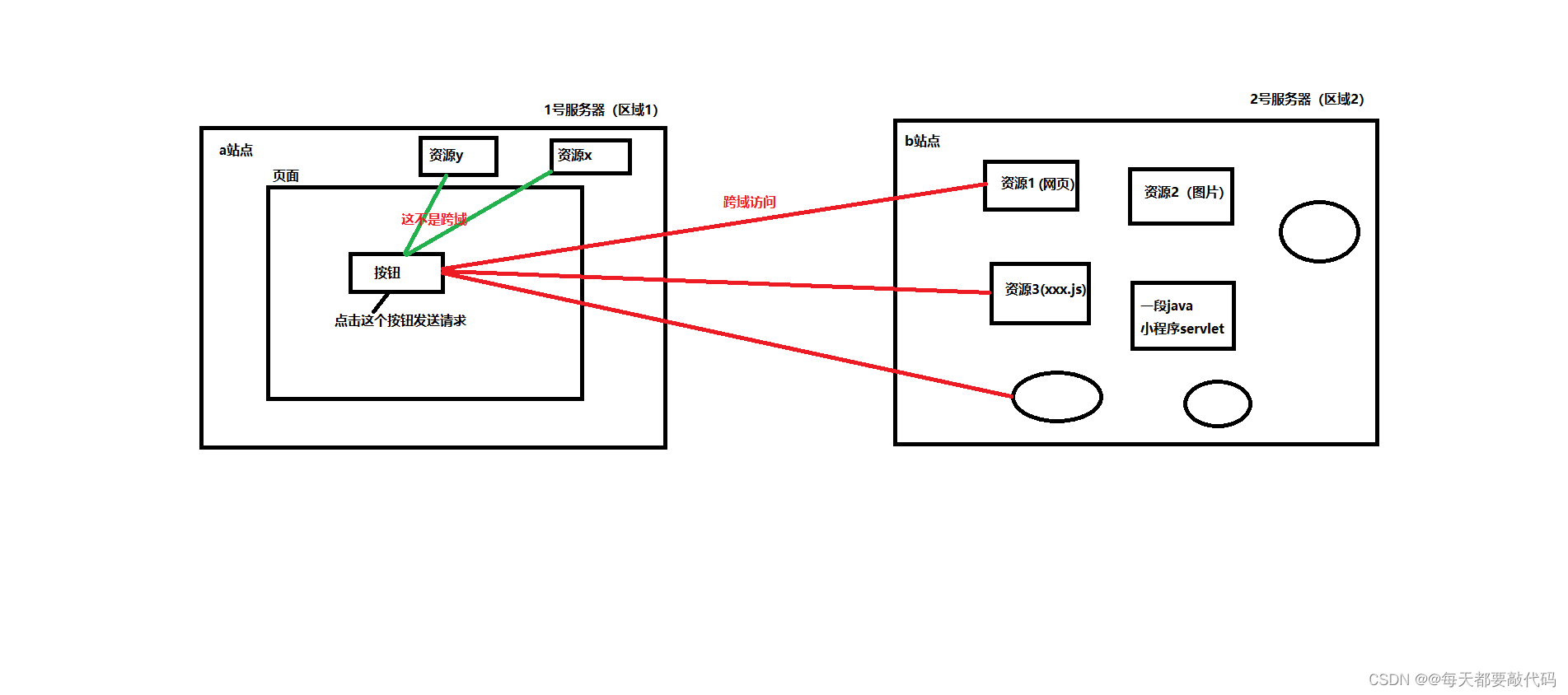
(6)测试
①对于超链接、form表单、JS代码;都是改变了地址栏的地址,是可以跨域访问的
②对于Ajax,并没有改变地址栏的地址,是不能跨域访问的
模拟超链接、form表单、JS代码方式跨域问题
步骤一:创建两个模块a和b,整两个Tomcat服务器
步骤二:默认a的HTTP端口号是8080,JMX端口号是1099;修改b的HTTP端口号为8081,JMX端口号是1098;不然在同一台服务器上端口号会冲突
步骤三:
①对于超链接,写两个index.html页面,就从a的index.html页面跨域访问b的index.html页面
②对于form表单的形式,a通过提交forrm表单发送数据,b接收请求在Servlet中获取数据
③对于JS代码,直接定义个按钮,通过点击事件onclick进行跳转到b的index.html
④通过<script>标签加载b站点的web根目录下的my.js文件
⑤使用img标签加载b站点的web目录下的baidu.png图片
😊对于a站点代码
index.html
<!DOCTYPE html>
<html lang="en">
<head>
<meta charset="UTF-8">
<title>a应用的index页面</title>
</head>
<body>
<!--通过超连接的方式-->
<a href="http://localhost:8081/b/index.html">b的index页面(跨域)</a>
<!--使用form表单-->
<form action="http://localhost:8081/b/user/reg" method="post">
用户名:<input type="text" name="username"><br>
密码:<input type="password" name="password"><br>
<input type="submit" value="注册">
</form>
<!--通过js代码中的window.location.href/document.location.href-->
<button onclick="window.location.href='http://localhost:8081/b/index.html'">b的index页面(跨域访问)</button>
<!--使用script标签加载js文件-->
<script type="text/javascript" src="http://localhost:8081/b/my.js"></script>
<!--加载b站点的图片-->
<br>
<img src="http://localhost:8081/b/baidu.png" />
</body>
</html>😊对于b站点代码
index.html
<!DOCTYPE html>
<html lang="en">
<head>
<meta charset="UTF-8">
<title>b应用的index页面</title>
</head>
<body>
<h1>b应用的index页面 </h1>
</body>
</html>请求Servlet
package com.bjpowernode.zl;
import javax.servlet.ServletException;
import javax.servlet.annotation.WebServlet;
import javax.servlet.http.HttpServlet;
import javax.servlet.http.HttpServletRequest;
import javax.servlet.http.HttpServletResponse;
import java.io.IOException;
@WebServlet("/user/reg")
public class UserRegServlet extends HttpServlet {
@Override
protected void doPost(HttpServletRequest request, HttpServletResponse response)
throws ServletException, IOException {
// 获取用户名和密码
String username = request.getParameter("username");
String password = request.getParameter("password");
// 响应到前端
response.getWriter().print(username + ":" + password);
}
}
web跟下的my.js文件和baidu.png图片

😊测试结果:以上请求都是支持跨域的,资源都能跨域访问到
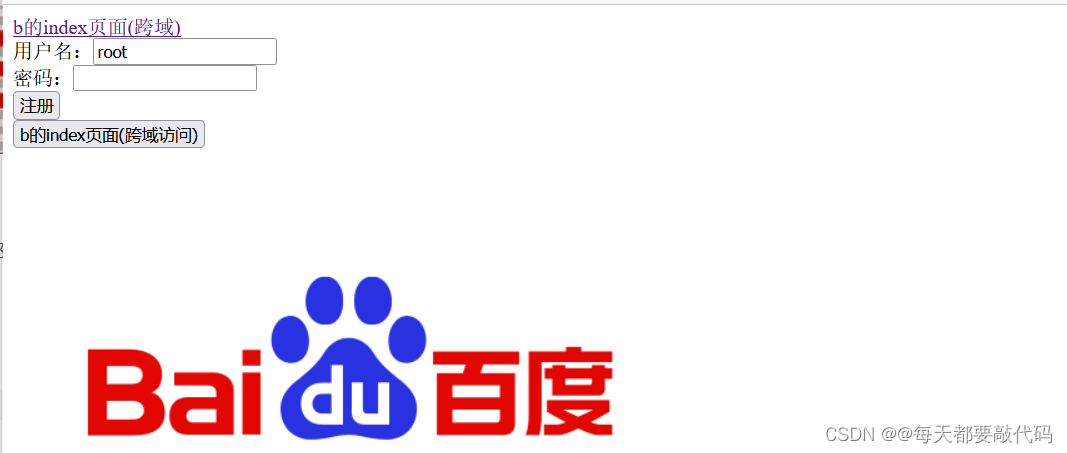
3、AJAX跨域问题
(1)测试Ajax跨域访问
①默认情况下:发送ajax跨域请求的时候会出现以下错误:Access to XMLHttpRequest at 'http://localhost:8081/b/hello' from origin 'http://localhost:8080' has been blocked by CORS policy:No 'Access-Control-Allow-Origin' header is present on the requested resource.
②出现这个错误的根本原因是:跨域的时候,不允许共享同一个XMLHttpRequest对象,因为共享同一个XMLHttpRequest对象是不安全的。
③重点提示:CORS策略阻止(这个ajax跨域请求被同源策略阻止)。
④什么是同源策略?同源策略是浏览器的一种安全策略。
a站点发送Ajax请求
<!DOCTYPE html>
<html lang="en">
<head>
<meta charset="UTF-8">
<title>测试:ajax跨域访问会不会有问题</title>
</head>
<body>
<script type="text/javascript">
window.onload = function(){
document.getElementById("btn").onclick = function(){
// 发送ajax的跨域请求
// 1. 创建核心对象
var xmlHttpRequest = new XMLHttpRequest();
// 2. 注册回调函数
xmlHttpRequest.onreadystatechange = function(){
if (xmlHttpRequest.readyState == 4) {
if (xmlHttpRequest.status >= 200 && xmlHttpRequest.status < 300) {
document.getElementById("mydiv").innerHTML = xmlHttpRequest.responseText
}
}
}
// 3. 开启通道
xmlHttpRequest.open("GET", "http://localhost:8081/b/hello", true)
// 4. 发送请求
xmlHttpRequest.send()
}
}
</script>
<button id="btn">发送ajax跨域请求</button>
<div id="mydiv"></div>
</body>
</html>b站点进行响应
package com.bjpowernode.zl;
import javax.servlet.ServletException;
import javax.servlet.annotation.WebServlet;
import javax.servlet.http.HttpServlet;
import javax.servlet.http.HttpServletRequest;
import javax.servlet.http.HttpServletResponse;
import java.io.IOException;
@WebServlet("/hello")
public class HelloServlet extends HttpServlet {
@Override
protected void doGet(HttpServletRequest request, HttpServletResponse response)
throws ServletException, IOException {
// 响应
response.getWriter().print("hello ajax!!!");
}
}
效果展示:Ajax请求时不支持跨域问题的

(2)同源 & 不同源
①区分同源和不同源的三要素:协议、域名、端口
②协议一致,域名一致,端口号一致,三个要素都一致,才是同源,其它一律都是不同源
③同源:XMLHttpRequest对象可以共享;不同源:XMLHttpRequest对象不可以共享。
④判别同不同源的例子:
| URL1 | URL2 | 是否同源 | 描述 |
|---|---|---|---|
| http://localhost:8080/a/index.html | http://localhost:8080/a/first | 同源 | 协议 域名 端口一致 |
| http://localhost:8080/a/index.html | http://localhost:8080/b/first | 同源 | 协议 域名 端口一致 |
| http://www.myweb.com:8080/a.js | https://www.myweb.com:8080/b.js | 不同源 | 协议不同 |
| http://www.myweb.com:8080/a.js | http://www.myweb.com:8081/b.js | 不同源 | 端口不同 |
| http://www.myweb.com/a.js | MyWeb2.com is for sale | HugeDomains | 不同源 | 域名不同 |
| http://www.myweb.com/a.js | http://crm.myweb.com/b.js | 不同源 | 子域名不同 |
(3)AJAX跨域解决方案1:设置响应头
①核心原理:跨域访问的资源允许你跨域访问。
②b站点的Servlet设置响应头,就表示允许你跨域访问。
③http://localhost:8080表示允许http协议、域名为localhost、端口号为8080的服务器跨域访问;*就表示允许所有的服务器进行跨域访问。
response.setHeader("Access-Control-Allow-Origin", "http://localhost:8080");
response.setHeader("Access-Control-Allow-Origin", "*"); b站点响应代码加上设置响应头
package com.bjpowernode.zl;
import javax.servlet.ServletException;
import javax.servlet.annotation.WebServlet;
import javax.servlet.http.HttpServlet;
import javax.servlet.http.HttpServletRequest;
import javax.servlet.http.HttpServletResponse;
import java.io.IOException;
@WebServlet("/hello")
public class HelloServlet extends HttpServlet {
@Override
protected void doGet(HttpServletRequest request, HttpServletResponse response)
throws ServletException, IOException {
// 设置响应头,允许ajax跨域请求
response.setHeader("Access-Control-Allow-Origin","http://localhost:8080");
// 响应
response.getWriter().print("hello ajax!!!");
}
}
效果展示:Ajax请求时跨域可以正常访问

(4)AJAX跨域解决方案2:jsonp
①jsonp:json with padding(带填充的json)
②jsonp不是一个真正的ajax请求,只不过可以完成ajax的局部刷新效果。可以说jsonp是一种类似ajax请求的机制!
③jsonp不是ajax请求,但是可以完成局部刷新的效果,并且可以解决跨域问题。
④注意:jsonp解决跨域的时候,只支持GET请求,不支持post请求!
⑤使用script标签,通过src属性发出请求,进行跨域访问!
😊jsop初步:其实Ajax没什么关系,发送Ajax请求是需要使用XMLHttpRequest对象的
a站点发送请求
<!DOCTYPE html>
<html lang="en">
<head>
<meta charset="UTF-8">
<title>jsonp实现跨域</title>
</head>
<body>
<!--定义一个函数-->
<script type="text/javascript">
/*function sayHello() {
alert("Hello World");
}*/
function sayHello(data) {
alert("username="+data.name)
}
</script>
<!--超链接也可以跨域,但是超链接点击之后会跳转页面,无法做到页面局部刷新效果
script标签只是跨域去调用资源,并不会修改地址跳转页面-->
<script type="text/javascript" src="http://localhost:8081/b/jsonp1?fun=sayHello">
</script>
</body>
</html>b站点进行响应
package com.bjpowernode.zl;
import javax.servlet.ServletException;
import javax.servlet.annotation.WebServlet;
import javax.servlet.http.HttpServlet;
import javax.servlet.http.HttpServletRequest;
import javax.servlet.http.HttpServletResponse;
import java.io.IOException;
import java.io.PrintWriter;
/**
* @Author:朗朗乾坤
* @Package:com.bjpowernode.zl
* @Project:ajax
* @name:JsonpServlet1
* @Date:2022/12/12 15:27
*/
@WebServlet("/jsonp1")
public class JsonpServlet1 extends HttpServlet {
@Override
protected void doGet(HttpServletRequest request, HttpServletResponse response)
throws ServletException, IOException {
request.setCharacterEncoding("UTF-8");
// 1、在后台进行输出一个普通的字符串
System.out.println("jsonp方式完成跨域访问");
// 2、向前端响应一段JS代码
PrintWriter out = response.getWriter();
// 这是响应一段js代码,只不过这个alert函数是JS内置的函数,可以直接用
out.print("alert(123)"); // 这行代码就相当于写到a站点.html的script标签里
// 3、调用函数
// 这也是响应一段JS代码,只不过这个sayHello函数是程序员自定义的
// 后端把sayHello()字符串响应到浏览器上,浏览器去调用这个函数
out.print("sayHello()");
// 4、函数中响应一个JSON数据
out.print("sayHello({\"name\" : \"jackson\"})");
// 5、动态获取函数名
String fun = request.getParameter("fun");
out.print(fun+"({\"name\" : \"jackson\"})");
}
}
😊jsonp深入:初步中页面一打开就加载script标签,并没有达到页面局部刷新的效果;我们要做的是先加载完,然后点击按钮才会加载script标签;实际上就是script标签中套script标签
a站点发送请求
script标签中套script标签四步:
①创建script元素对象:document.createElement("script");②设置script的type属性:script元素对象.type = "text/javascript"
③设置script的src属性:script元素对象.src = "http://localhost:8081/b/jsonp2?fun=sayHello"
④加载script,将script对象添加到body标签中:document.getElementsByTagName("body")[0].appendChild(htmlScriptElement)
<!DOCTYPE html>
<html lang="en">
<head>
<meta charset="UTF-8">
<title>jsonp跨域深入</title>
</head>
<body>
<script type="text/javascript">
// 自己定义的函数
function sayHello(data) {
document.getElementById("mydiv").innerHTML = data.username
}
// 点击按钮加载script标签
window.onload = function () {
document.getElementById("btn").onclick = function () {
// 加载script元素
//1.创建script元素对象
var htmlScriptElement = document.createElement("script");
//2.设置script的type属性
htmlScriptElement.type = "text/javascript"
//3.设置script的src属性
htmlScriptElement.src = "http://localhost:8081/b/jsonp2?fun=sayHello"
// 将script对象添加到body标签中(这一步就是加载script)
document.getElementsByTagName("body")[0].appendChild(htmlScriptElement)
}
}
</script>
<button id="btn">jsonp解决跨域问题,达到ajax局部刷新的效果</button>
<div id="mydiv"></div>
</body>
</html>b站点进行响应
package com.bjpowernode.zl;
import javax.servlet.ServletException;
import javax.servlet.annotation.WebServlet;
import javax.servlet.http.HttpServlet;
import javax.servlet.http.HttpServletRequest;
import javax.servlet.http.HttpServletResponse;
import java.io.IOException;
@WebServlet("/jsonp2")
public class JSONPServlet2 extends HttpServlet {
@Override
protected void doGet(HttpServletRequest request, HttpServletResponse response)
throws ServletException, IOException {
// 获取函数名
String fun = request.getParameter("fun");
// 响应一段js代码
response.getWriter().print(fun + "({\"username\" : \"lucy\"})");
}
}
(5)AJAX跨域解决方案3:jQuery封装的jsonp
①大牛们写的jQuery库,已经对jsonp进行了封装,可以直接拿来用。
②用之前需要引入jQuery库的js文件。
③jQuery中的jsonp其实就是我们上面代码的高度封装,底层原理完全相同。
④核心代码
$.ajax({
type : "GET",
url : "跨域的url",
dataType : "jsonp", // 指定数据类型
jsonp : "fun", // 指定参数名(不设置的时候,默认是:"callback")
jsonpCallback : "sayHello" // 指定回调函数的名字
// (不设置的时候,jQuery会自动生成一个随机的回调函数,
//并且这个回调函数还会自动调用success的回调函数。)
})步骤一:先创建一个目录,然后把官方的jQuery放进去

步骤二:
前端代码
第一种方式:全都采用默认的方式
虽然url : "http://localhost:8081/b/jsonp3"这样传,但是实际上会自动转换为以下代码
http://localhost:8081/b/jsonp3?callback=jQuery36006725923678901025_1670837696149&_=1670837696150
①callback=jQuery36006725923678901025_1670837696149,callback就是name相当于之前的fun;
②jQuery36006725923678901025_1670837696149就是函数名,相当于之前的sayHello,而这个名字是jQuery自动为我们生成的;
③&_=1655528968613是一个时间戳。
④并且自动生成的这个函数,默认情况还会自动调用我们传的success回调函数
⑤最关键的是传参的时候要指定数据类型是jsonp形式,dataType : "jsonp"
<!DOCTYPE html>
<html lang="en">
<head>
<meta charset="UTF-8">
<title>jQuery的jsonp封装解决ajax跨域问题</title>
</head>
<body>
<!--引入jQuery库-->
<script type="text/javascript" src="/a/js/jquery-3.6.0.min.js"></script>
<script type="text/javascript">
$(function () {
$("#btn").click(function () {
// 发送所谓的ajax请求,实际上并不是
$.ajax({ // 传一个JSON数据过去
type : "GET", // jsonp请求只支持get请求。
url : "http://localhost:8081/b/jsonp3",
dataType : "jsonp", // 指定数据类型是jsonp形式。【跨域最关键的是它】
success : function (data) { // data是一个json:{"username":"lisi"})
$("#mydiv").html(("欢迎你:" + data.username))
}
})
})
})
</script>
<button id="btn">jQuery库封装的jsonp</button>
<div id="mydiv"></div>
</body>
</html>第二种方式:采用自定义的方式
①使用jsonp属性,用来指定参数的名字
②使用jsonpCallback属性,用这个属性来指定具体的回调函数
<!DOCTYPE html>
<html lang="en">
<head>
<meta charset="UTF-8">
<title>jQuery的jsonp封装解决ajax跨域问题</title>
</head>
<body>
<!--引入jQuery库-->
<script type="text/javascript" src="/a/js/jquery-3.6.0.min.js"></script>
<script type="text/javascript">
// 自定义函数
function sayHello(data) {
$("#mydiv").html(("欢迎你:" + data.username))
}
$(function () {
$("#btn").click(function () {
// 发送所谓的ajax请求,实际上并不是
$.ajax({ // 传一个JSON数据过去
type : "GET", // jsonp请求只支持get请求。
url : "http://localhost:8081/b/jsonp3",
dataType : "jsonp", // 指定数据类型是jsonp形式。【跨域最关键的是它】
jsonp : "fun",
/*第一种方式
jsonpCallback : function (data) {
$("#mydiv").html(("欢迎你:" + data.username))
}*/
// 第二种方式
jsonpCallback : "sayHello"
})
})
})
</script>
<button id="btn">jQuery库封装的jsonp</button>
<div id="mydiv"></div>
</body>
</html>后端代码
①采用默认的方式,name就是callback,通过name获取对应的函数名
②采用自定义的方式,通过前端定义的jsonp属性指定的名字获取函数名
package com.bjpowernode.zl;
import javax.servlet.ServletException;
import javax.servlet.annotation.WebServlet;
import javax.servlet.http.HttpServlet;
import javax.servlet.http.HttpServletRequest;
import javax.servlet.http.HttpServletResponse;
import java.io.IOException;
@WebServlet("/jsonp3")
public class JSONPServlet3 extends HttpServlet {
@Override
protected void doGet(HttpServletRequest request, HttpServletResponse response)
throws ServletException, IOException {
// 获取函数名,callback名称是默认的
String callback = request.getParameter("callback");
// 响应一段js代码,调用函数
response.getWriter().print(callback + "({\"username\":\"lisi\"})");
// 获取函数名,使用自定义的
String fun = request.getParameter("fun");
// 响应一段js代码,调用函数
response.getWriter().print(fun + "({\"username\":\"lisi\"})");
}
}
(6)AJAX跨域解决方案4:代理机制(httpclient)
(1)代理机制:既然服务及不能直接跨域发送Ajax请求访问;那么先不跨域发送Ajax请求给Servlet,然后在通过这个Servlet(java代码)发送请求进行跨域访问!
(2)使用Java程序怎么去发送get/post请求呢?【GET和POST请求就是HTTP请求。】
①第一种方案:使用JDK内置的API(java.net.URL.....),这些API是可以发送HTTP请求的;但是编写代码很麻烦,不建议使用。
②第二种方案:使用第三方的开源组件,比如:apache的httpclient组件。(httpclient组件是开源免费的,可以直接用)
(3)在java程序中,使用httpclient组件可以发送http请求。
①对于httpclient组件的代码,目前可以不进行深入的研究,可以从网上直接搜;然后粘贴过来,改一改,看看能不能完成发送get和post请求。
②使用httpclient组件,需要将这个组件相关的jar包引入到项目当中。
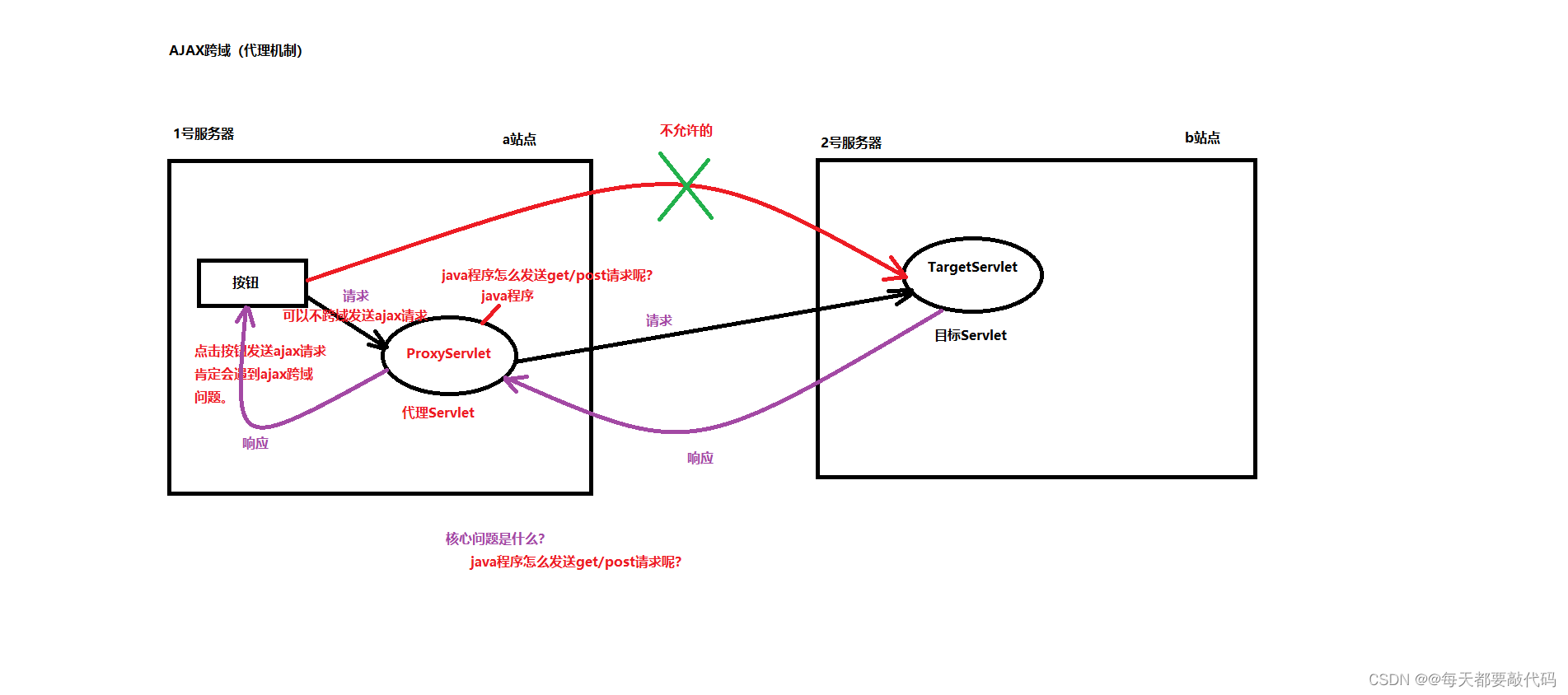
a站点的前端代码
<!DOCTYPE html>
<html lang="en">
<head>
<meta charset="UTF-8">
<title>使用代理机制完成ajax跨域访问</title>
</head>
<body>
<script type="text/javascript">
// ES6当中的有一个新语法:箭头函数。
window.onload = function() {
document.getElementById("btn").onclick = function() {
// 发送ajax请求
// 1.创建核心对象
var xmlHttpRequest = new XMLHttpRequest(); // const可以声明变量。(可以自己研究一下:var let const声明变量时有什么区别)
// 2.注册回调函数
xmlHttpRequest.onreadystatechange = function() {
if (xmlHttpRequest.readyState == 4) {
// 这里也可以使用区间的方式,因为状态码是200~299都是正常响应结束。
if (xmlHttpRequest.status >= 200 && xmlHttpRequest.status < 300) {
document.getElementById("mydiv").innerHTML = xmlHttpRequest.responseText
}
}
}
// 3.开启通道
xmlHttpRequest.open("GET", "/a/proxy", true)
// 4.发送请求
xmlHttpRequest.send()
}
}
</script>
<button id="btn">使用代理机制解决ajax跨域访问</button>
<div id="mydiv"></div>
</body>
</html>a站点的Servlet代码,代理Servlet,先引入jar包手动Add,再在java代码中发送GET请求

package com.bjpowernode.zl;
import javax.servlet.ServletException;
import javax.servlet.annotation.WebServlet;
import javax.servlet.http.HttpServlet;
import javax.servlet.http.HttpServletRequest;
import javax.servlet.http.HttpServletResponse;
import org.apache.http.HttpEntity;
import org.apache.http.HttpResponse;
import org.apache.http.client.methods.HttpGet;
import org.apache.http.impl.client.CloseableHttpClient;
import org.apache.http.impl.client.HttpClients;
import java.io.BufferedReader;
import java.io.IOException;
import java.io.InputStreamReader;
@WebServlet("/proxy")
public class ProxyServlet extends HttpServlet {
@Override
protected void doGet(HttpServletRequest request, HttpServletResponse response)
throws ServletException, IOException {
// 通过httpclient组件,发送HTTP GET请求,访问 TargetServlet
HttpGet httpGet = new HttpGet("http://localhost:8081/b/target");
httpGet.setHeader("Content-Type", "application/x-www-form-urlencoded");
CloseableHttpClient httpClient = HttpClients.createDefault();
HttpResponse resp = httpClient.execute(httpGet);
HttpEntity entity = resp.getEntity();
BufferedReader reader = new BufferedReader(new InputStreamReader(entity.getContent(), "UTF-8"));
String line = null;
StringBuffer responseSB = new StringBuffer();
while ((line = reader.readLine()) != null) {
responseSB.append(line);
}
reader.close();
httpClient.close();
// b站点响应回来的数据
response.getWriter().print(responseSB);
}
}
b站点的Servlet,会返回一个json格式的字符串
package com.bjpowernode.zl;
import javax.servlet.ServletException;
import javax.servlet.annotation.WebServlet;
import javax.servlet.http.HttpServlet;
import javax.servlet.http.HttpServletRequest;
import javax.servlet.http.HttpServletResponse;
import java.io.IOException;
@WebServlet("/target")
public class TargetServlet extends HttpServlet {
@Override
protected void doGet(HttpServletRequest request, HttpServletResponse response)
throws ServletException, IOException {
// 响应一个json字符串。
response.getWriter().print("{\"username\":\"jackson\"}");
}
}
执行结果,也能完整跨域访问

(7)AJAX跨域解决方案5:nginx反向代理
nginx反向代理中也是使用了这种代理机制来完成AJAX的跨域,实现起来非常简单,只要修改一个nginx的配置即可。后面学习到互联网分布式技术会细讲!



